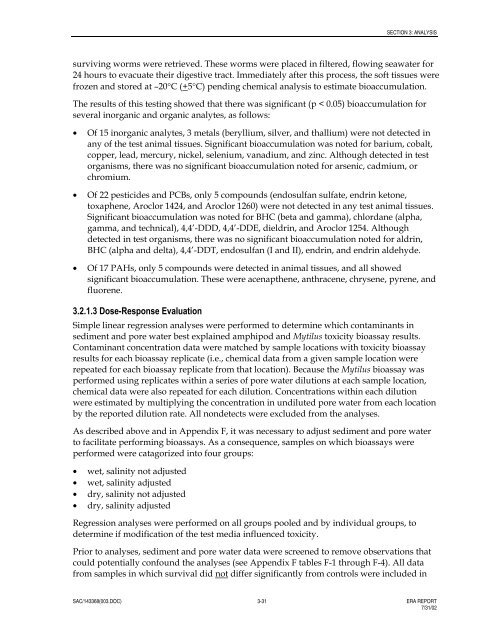1.1 MB pdf - Bolsa Chica Lowlands Restoration Project
1.1 MB pdf - Bolsa Chica Lowlands Restoration Project
1.1 MB pdf - Bolsa Chica Lowlands Restoration Project
You also want an ePaper? Increase the reach of your titles
YUMPU automatically turns print PDFs into web optimized ePapers that Google loves.
SECTION 3: ANALYSIS<br />
surviving worms were retrieved. These worms were placed in filtered, flowing seawater for<br />
24 hours to evacuate their digestive tract. Immediately after this process, the soft tissues were<br />
frozen and stored at –20°C (+5°C) pending chemical analysis to estimate bioaccumulation.<br />
The results of this testing showed that there was significant (p < 0.05) bioaccumulation for<br />
several inorganic and organic analytes, as follows:<br />
• Of 15 inorganic analytes, 3 metals (beryllium, silver, and thallium) were not detected in<br />
any of the test animal tissues. Significant bioaccumulation was noted for barium, cobalt,<br />
copper, lead, mercury, nickel, selenium, vanadium, and zinc. Although detected in test<br />
organisms, there was no significant bioaccumulation noted for arsenic, cadmium, or<br />
chromium.<br />
• Of 22 pesticides and PCBs, only 5 compounds (endosulfan sulfate, endrin ketone,<br />
toxaphene, Aroclor 1424, and Aroclor 1260) were not detected in any test animal tissues.<br />
Significant bioaccumulation was noted for BHC (beta and gamma), chlordane (alpha,<br />
gamma, and technical), 4,4’-DDD, 4,4’-DDE, dieldrin, and Aroclor 1254. Although<br />
detected in test organisms, there was no significant bioaccumulation noted for aldrin,<br />
BHC (alpha and delta), 4,4’-DDT, endosulfan (I and II), endrin, and endrin aldehyde.<br />
• Of 17 PAHs, only 5 compounds were detected in animal tissues, and all showed<br />
significant bioaccumulation. These were acenapthene, anthracene, chrysene, pyrene, and<br />
fluorene.<br />
3.2.1.3 Dose-Response Evaluation<br />
Simple linear regression analyses were performed to determine which contaminants in<br />
sediment and pore water best explained amphipod and Mytilus toxicity bioassay results.<br />
Contaminant concentration data were matched by sample locations with toxicity bioassay<br />
results for each bioassay replicate (i.e., chemical data from a given sample location were<br />
repeated for each bioassay replicate from that location). Because the Mytilus bioassay was<br />
performed using replicates within a series of pore water dilutions at each sample location,<br />
chemical data were also repeated for each dilution. Concentrations within each dilution<br />
were estimated by multiplying the concentration in undiluted pore water from each location<br />
by the reported dilution rate. All nondetects were excluded from the analyses.<br />
As described above and in Appendix F, it was necessary to adjust sediment and pore water<br />
to facilitate performing bioassays. As a consequence, samples on which bioassays were<br />
performed were catagorized into four groups:<br />
• wet, salinity not adjusted<br />
• wet, salinity adjusted<br />
• dry, salinity not adjusted<br />
• dry, salinity adjusted<br />
Regression analyses were performed on all groups pooled and by individual groups, to<br />
determine if modification of the test media influenced toxicity.<br />
Prior to analyses, sediment and pore water data were screened to remove observations that<br />
could potentially confound the analyses (see Appendix F tables F-1 through F-4). All data<br />
from samples in which survival did not differ significantly from controls were included in<br />
SAC/143368(003.DOC) 3-31 ERA REPORT<br />
7/31/02






